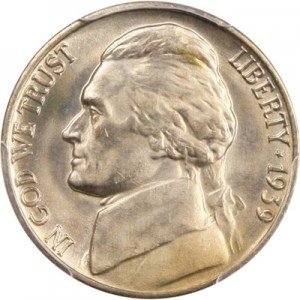

In the year 1938, The U.S. Mint replaced its Buffalo Nickel with the Jefferson nickel. This was a completely new design for the mint’s popular five cent piece, and this design is still being produced today. While some might assume that a Jefferson Nickel has little to no collectable value, certain years of this coin in certain conditions can be highly valued by collectors.
It is important to note, however, that a Jefferson Nickel will only have any significant value if it is in excellent overall condition. Coins in this condition are not only worth more money, but have a more attractive appearance as well.
For a coin that has been around for 75+ years, the key to a coin’s potential value lies in its condition. While some coins may be valuable regardless of condition due to other factors such as scarcity or mint year, collectors are typically looking for coins that are in pristine condition and appear to be freshly minted. Finding such coins can prove challenging, however, as most have been circulated for some time now.
When examining a coin’s condition, you are effectively assigning a grade to your coin. Grading is often performed by professional numismatists, but you can use the guidelines below to get a good idea of what a graded Jefferson Nickel might look like.
Uncirculated: The uncirculated Jefferson Nickel is the type most sought after by coin collectors. Because these coins have never been circulated, they have not been subjected to normal everyday wear and tear. A simple look at these coins will give you the impression that they were just minted today, and they will appear brand new.
Extremely Fine: Jefferson Nickels that are graded extremely fine are still coveted by coin collectors; however, these coins will have some minor surface damage or other imperfections. To the naked eye, the coin may look perfect, but under closer inspection these blemishes may be revealed.
Fine: A coin that is assigned a grade of fine has typically been in circulation for some time. Having exchanged hands many times over, these coins will show wear and tear from handling. This wear and tear, however, is not significant enough to lessen the integrity of the coin’s images or markings.
Good: The majority of Jefferson Nickels on the market today are assigned this grade. These coins have been heavily circulated, and show their age. Collectors will most often pass on these coins, and look for coins in better condition. The 1939 Jefferson Nickel may, however, still garner some interest from collectors because it is one of the first editions produced.
To assign an accurate grade to a coin, you must first look at what type of coin it is. There were various types of 1939 Jefferson Nickels produced. The type of nickel will play a large role in the coin’s value. In addition to the coin type, the coin’s condition will be of the utmost importance to collectors. Coins in excellent condition can sell for vastly more money than coins in good condition. The chart below will provide you with a good idea as to how much you may pay for a Jefferson Nickel given its type and grade.

1939 Jefferson Nickel
| DATE | GOOD | FINE | EXTREMELY FINE | UNCIRCULATED |
|---|---|---|---|---|
| 1939 Jefferson Nickel | N/A | N/A | $0.50 | $1 |
| 1939 Jefferson Nickel (D) | N/A | N/A | $13 | $30 |
| 1939 Jefferson Nickel (S) | N/A | N/A | $0.50 | $1 | Source: Red Book |